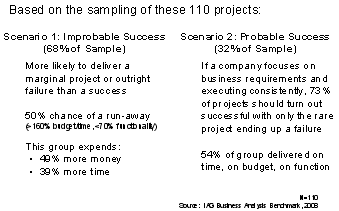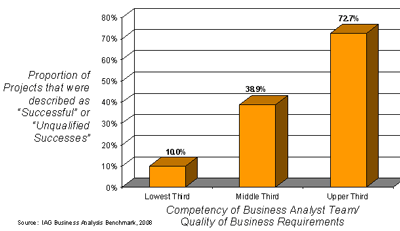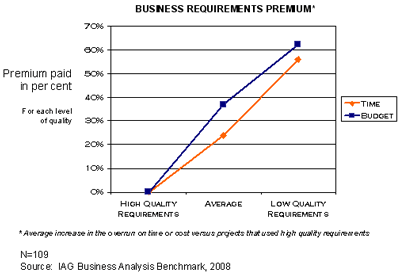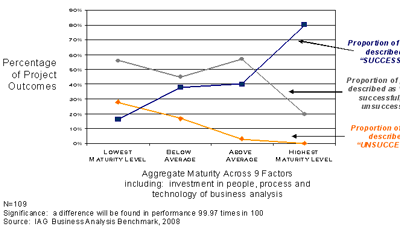The Strategic Role of the Business Analyst
The new role of the BA is far more strategic in both the organizational sense as well as at the project level. In fact, I would go as far as to say that the BA, when appropriately leveraged, represents a liaison between business, project and customer teams. This shift in responsibilities identifies two areas that need to be addressed by any organization seeking to expand this role:
-
The organizational structure must support the actions of a “strategic” BA position
-
The BA candidate must have wide skill sets, encompassing many general management competencies
As organizations shift to become “projectized,” the roles and responsibilities that have supported projects within a traditional matrix structure must shift as well. Over the years we have seen organizations struggle with the following challenges related to shifts in both structure and culture:
-
Broken or disjointed cross-functional communication channels
-
Uncertainty around roles and responsibilities within the project structure and beyond
-
Quality concerns at the point of project delivery
-
Skewed scope statements and thus implementation plans due to early stage breakdown
-
Overall loss of productivity on project teams due to lack of continuity and methods
The items noted above are telltale signs that several strategic components of a best practice project management environment are missing.
Forward looking or “best in class” organizations have aggressively embraced the concept of the BA role. And, what sets them apart from the old school thinking associated with this job title is the escalation and expansion of the roles, definition and responsibilities. Not too many years ago a BA may have been confined to a very technical role within an IT environment working on specifications, functionality and even some quality and testing related to one or more project life cycles. Today, we are seeing BA positions filled from across the organization and expect that this trend will continue, as it should.
Let’s address these points built in the context of how they can be leveraged to meet the challenges:
Broken or disjointed cross-functional communication channels
A BA should be in front of any project communication produced from the point of team inception to the close-out phase. This interaction does not mean that the BA takes on the role of project manager (although we have seen organizations combine the two roles), as it is not effective on larger and longer term initiatives. Our experience shows that an independent BA position can help to promote better communication, align protocol and help the project manager to extend his/her reach into the project teams.
Uncertainty around roles and responsibilities within the project structure and beyond
The BA functions as a tour guide through the project plan ensuring that all of the moving pieces are touching at the right points. We call these critical communication points and they can be built around time, budget or deliverable expectations. The BA will be assigned a protocol map within the project structure to enable them better access to expectations and provide for a proactive way to reach team members.
Quality concerns at the point of project delivery
In reality, the BA is monitoring quality points through the project life cycle thus producing a quality product at the close of the project. Very much like the thinking around proactive quality control, the BA is in front of each deliverable and monitors the progress against the project plan. This allows for immediate communication between the project manager, customer and associated teams.
Skewed scope statements and thus implementation plans due to early stage breakdown
The planning stages of a project are obviously critical to the implementation plan and ultimate quality. A BA should be assigned early in the process and work hand in hand with the project manager to ensure the highest level of intimacy with the plan. And, just as importantly they need to have a direct connection to the internal and external customers in order to ensure collaboration and proactive attention to emerging issues.
Overall loss of productivity on project teams due to lack of continuity and methods
A strategic BA assists the project manger and PMO with the execution of best practice within an organization’s project management structure. The BA has a unique opportunity to guide the process through an existing methodology and essentially help the project to operate in better alignment. This is accomplished by having a dedicated individual who is consistently working against the deliverables and is not distracted by the operations management associated with the project manager’s job.
By taking the above steps you have begun the shift toward the organizational structure needed to take advantage of the BA position. With that said, we still have one more change to make in order to secure success.
It is obvious that the BA role as defined in this article will require wider skill sets than the more traditional BA position still driven from the IT departments of yester year. To that point we have begun to see a trend where the BA position can spawn from either business or IT. This is an interesting point as it speaks volumes to an organization’s maturity around project management. Imagine, for just a moment, an organization that has no boundaries within in its functions and everyone on the team collaborates against a common goal. I like to call this organizational desegregation and cultural morphing. As we begin the next phase of benchmarking the project management industry and clients, we are beginning to see this shift as a representative of the next wave of advancing thought in the project management space. It was not too many years ago that I published an article on the emerging role of the project manager as the CEO of his/her project. I am confident that the BA role will take a firmly positioned spot in the upper hierarchy of any world class project organization within the next few years.
In order to succeed the BA will need to have a competency profile that meets the following criteria:
-
Excellent understanding of both business and technology within the project environment.
-
Be a leader, communicator and professional.
-
Understand the skills associated with internal consulting techniques.
-
Be proficient in project management skills as well as complete understanding of the internal process.
-
Epitomize the essence of a collaborator and team player.
-
Understand and be able to navigate your organization’s politics and structure.
-
Be able to manage, without having authority, via negotiation.
-
Understand true stewardship-based service.
So, the BA role probably looks a little different than a traditional structure may have dictated. Yet, this is the trend and I believe will become the norm. As organizations look to enhance productivity and quality while reducing cost they are finding this role to be ultimately important. Additionally, project managers we spoke to during the research for this article all stated that having a BA on the team made their job easier and allowed them to focus on deliverable based activity.
It is important to note that this type of structure is recommended for mid to large size projects, but on the smaller initiatives we found that these attributes were part of the project manager’s role.
Phil Ventresca, MBA is Founder, CEO and President of Advanced Management Services, Inc. (AMS), http://www.amsconsulting.com/, a full service management consultancy servicing an international client base. Phil has utilized his extensive background in management and consulting to lead AMS to its current status as a multi-million dollar enterprise with an international customer base. He has led the organization to recognize several strategic breakthroughs such as developing partnerships with distance education providers, software developers and publishers. Through these efforts, AMS has emerged as a leader in consulting, training and assessment services.
His entrepreneurial spirit and keen business insight has benefited many organizations through his consultive engagements with clients such as Boston Edison, ADP, State Street Bank, Cabot Corporation, Merisel, Data General, Simplex, AT&T, BIC, Bank of Montreal, Kronos and others. Phil is an adjunct faculty member at Boston University’s Division of Extended Education. He is responsible for the development and delivery of a project management curriculum to varied international client base as well as a contributor to a unique leadership development program. Phil can be reached at [email protected] or 781-828-8210.


 Companies with poor business analysis capability will have three times as many project failures as successes.
Companies with poor business analysis capability will have three times as many project failures as successes.  Companies pay a premium of as much as 60% on time and budget when they use poor requirements practices on their projects.
Companies pay a premium of as much as 60% on time and budget when they use poor requirements practices on their projects.  80% of projects where successful from companies with mature requirements process, technology and competencies.
80% of projects where successful from companies with mature requirements process, technology and competencies. 
 We’re just into our second month of this Leap Year with our “once in four one day more” 29 day February and already we’re up to our necks in activity, getting each Business Analyst Times online, planning for the next one and organizing a year’s worth of Business Analyst Worlds.
We’re just into our second month of this Leap Year with our “once in four one day more” 29 day February and already we’re up to our necks in activity, getting each Business Analyst Times online, planning for the next one and organizing a year’s worth of Business Analyst Worlds.